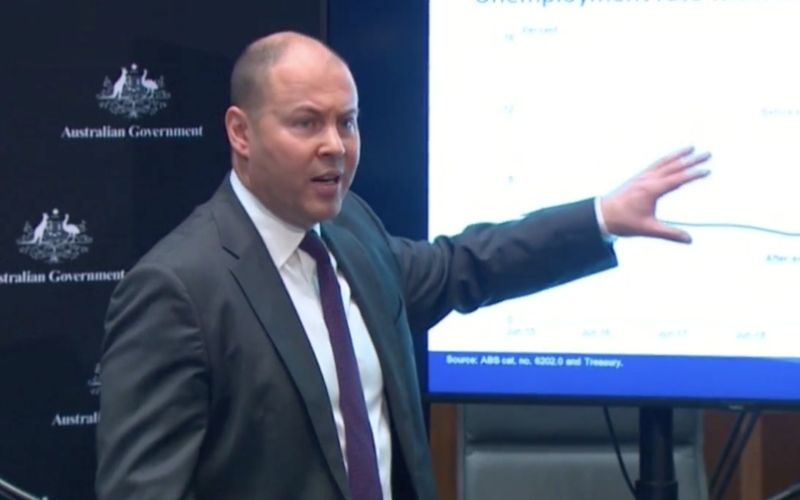The Australian economy was in pretty good shape going into this pandemic. It’s fair to say, if you had to be in any country in the world to get through this recession it would be Australia.
ECONOMY
Real GDP is forecast to fall by 3. per cent in 2020 before recovering in 2021 to grow by 4. per cent.
The unemployment rate is expected to peak at around 8 per cent in the December quarter of this year, before falling over the next few years as the economy recovers and businesses gain confidence to employ more workers. By the June quarter 2022, the unemployment rate is expected to be 6. per cent and will continue to decline over the forecast period.
Real GDP fell by 7.0 per cent in the June quarter 2020 after a modest contraction of 0.3 per cent in the March quarter, as travel restrictions and other pandemic containment measures affected the ability of consumers and businesses to undertake their usual spending and investment activities.
As the virus has come under control and containment measures have been eased, the jobs lost have started to come back. Of the 1.3 million people who lost their job or were stood down on zero hours for economic reasons in April, almost 60 per cent or 760,000 are now back at work.
Economic activity is forecast to pick up strongly from late 2020 and into early 2021, driven by a further easing of containment measures and improving business and consumer confidence. Activity will also be significantly supported by an unprecedented $257 billion in Government economic support
SMALL BUSINESS
This year’s Federal Budget is squarely aimed at keeping Australian business viable and positive enough to keep staff and hire more.
The incentives are huge.
JobKeeper keeps going;
As we know already, the $101 billion JobKeeper program keeps going until the end of March even though the amount is reduced and eligibility rules have been tightened.
Those not on JobKeeper receive a JobMaker “hiring credit” to employ more staff
For businesses not on JobKeeper they can receive a “hiring credit” of $200 a week if they add an eligible under 30 year old to their staff and $100 a week for a 30-35 year old new employee.
From 7 October 2020, eligible employers will be able to claim $200 a week for each additional eligible employee they hire aged 16 to 29 years old; and $100 a week for each additional eligible employee aged 30 to 35 years old.
New jobs created until 6 October 2021 will attract the JobMaker Hiring Credit for up to 12 months from the date the new position is created.
To be eligible, the employee must have received the JobSeeker Payment, Youth Allowance (Other), or Parenting Payment for at least one of the previous three months at the time of hiring.
The JobMaker Hiring Credit will be claimed quarterly in arrears by the employer from the Australian Taxation Office (ATO) from 1 February 2021. Employers will need to report quarterly that they meet the eligibility criteria.
The JobMaker Hiring Credit is designed to support new employment. Employers do not need to satisfy a fall in turnover test.
To attract the JobMaker Hiring Credit, the employee must be in an additional job created from 7 October 2020. To demonstrate that the job is additional, specific criteria must be met.
The additionality criteria require that there is an increase in:
- the business’ total employee headcount (minimum of one additional employee) from the reference date of 30 September 2020; and
- the payroll of the business for the reporting period, as compared to the three months to 30 September 2020.
The amount of the hiring credit claim cannot exceed the amount of the increase in payroll for the reporting period.
Total employee headcount on 30 September 2020 and payroll in the three months to 30 September 2020 represent the baseline values for the employer.
The baseline headcount will be adjusted in the second year of the program to ensure an employer can only receive the JobMaker Hiring Credit for 12 months for each additional position created.
Employers are eligible to receive the JobMaker Hiring Credit if they:
- have an Australian Business Number (ABN);
- are up to date with tax lodgement obligations;
- are registered for Pay As You Go (PAYG) withholding;
- are reporting through Single Touch Payroll (STP);
- meet the additionality criteria;
- are claiming in respect of an eligible employee; and
- have kept adequate records of the paid hours worked by the employee they are claiming the hiring credit in respect of.
Offsetting a loss this year against the PAST 2 years profits
If a business makes a loss this financial year they can offset that loss against profits they’ve made in the past 2 years (usually they can only offset losses against future profits). While they’ve already paid tax on those past profits, they’ll get a refund back once the losses are offset against them.
The Government will also allow companies with turnover up to $5 billion to offset losses against previous profits on which tax has been paid, to generate a refund. Loss carry-back will be available to around 1 million companies that employ up to 8.8 million workers.
Losses incurred up to 2021-22 can be carried back against profits made in or after 2018-19. Eligible companies may elect to receive a tax refund when they lodge their 2020-21 and 2021-22 tax returns.
Immediate Asset write-off
Any investment in new assets for the business can be written off against their tax immediately instead of over a few years. Less tax means more money to spend or hire more staff.
From 7:30pm (AEDT) on 6 October 2020 until 30 June 2022, businesses with turnover up to $5 billion will be able to deduct the full cost of eligible depreciable assets of any value in the year they are installed. The cost of improvements to existing eligible depreciable assets made during this period can also be fully deducted.
The Australian economy was in pretty good shape going into this pandemic. It’s fair to say, if you had to be in any country in the world to get through this recession it would be Australia.
PERSONAL TAX … INDIVIDUALS
Under the Government’s changes, individuals will benefit from bringing forward the tax cuts in Stage 2 of its Plan, as well as a one-off additional benefit from the low- and middle-income tax offset in 2020-21.
The majority of the benefit for 2020-21 will go to those on incomes below $90,000.
Treasury estimates that reducing the personal income tax burden on hard-working Australians will boost GDP by around $3.5 billion in 2020-21 and $9 billion in 2021-22 and will create an additional 50,000 jobs by the end of 2021-22.
Personal income tax cuts announced in the last two budgets helped to put more money into the pockets of hard-working Australians and in the process strengthen our economy to respond to the impact of COVID-19.
As part of the 2020-21 Budget we will bring forward Stage two of our Personal Income Tax Plan by two years. From 1 July 2020:
- The low income tax offset will increase from $445 to $700;
- The top threshold of the 19 per cent tax bracket will increase from $37,000 to $45,000; and
- The top threshold of the 32.5 per cent tax bracket will increase from $90,000 to $120,000.
The Government will also provide additional targeted support to low- and middle-income Australians. In 2020-21, low-and middle-income earners will receive a one-off additional benefit of up to $1,080 from the low and middle income tax offset (LMITO).
The LMITO was to be removed with the commencement of Stage two, but the one-off additional benefit in 2020-21 will provide support to households and stimulus to the economy
SUPERANNUATION
The Government’s Your Future, Your Super reforms are the next phase of the Government’s reform agenda and will see
Australians save $17.9 billion over the next decade
Unintended superannuation accounts erode members’ balances through unnecessary fees and insurance premiums.
For the first time, Australians will automatically keep their superannuation fund when they change employers. ‘Stapling’ the super fund to the employee will ensure that their super follows them when they change jobs, stopping the creation of unintended multiple accounts.
Empowering members
The Government is making it simple for Australians to choose a better super fund. This will result in more competition, which will drive down fees and increase retirement savings.
The new online YourSuper comparison tool will help people compare the performance of MySuper products and make it easy to choose a fund.
Holding funds to account for underperformance
The Government is protecting members from super funds that deliver poor outcomes by requiring funds to meet an annual performance test. If funds fail the test they will be required to write to inform members and give them the option to move their money to a better performing fund.
Funds that continue to underperform will no longer be allowed to receive new members until their performance improves.
Now to your boss. What’s in this Budget to keep them positive, keep you in a job and create more jobs;
- As we know already, the $101 billion JobKeeper program keeps going until the end of March even though the amount is reduced and eligibility rules have been tightened.
- For businesses not on JobKeeper they can receive a “hiring credit” of $200 a week if they add an eligible under 30 year old to their staff and $100 a week for a 30-35 year
old new employee. - If their business makes a loss this financial year they can offset that loss against profits they’ve made in the past 2 years (usually they can only offset losses against future profits). While they’ve already paid tax on those past profits, they’ll get a refund back once the losses are offset against them.
- Any investment in new assets for the business can be written off against their tax immediately instead of over a few years. Less tax means more money to spend or hire more staff.





























Trending